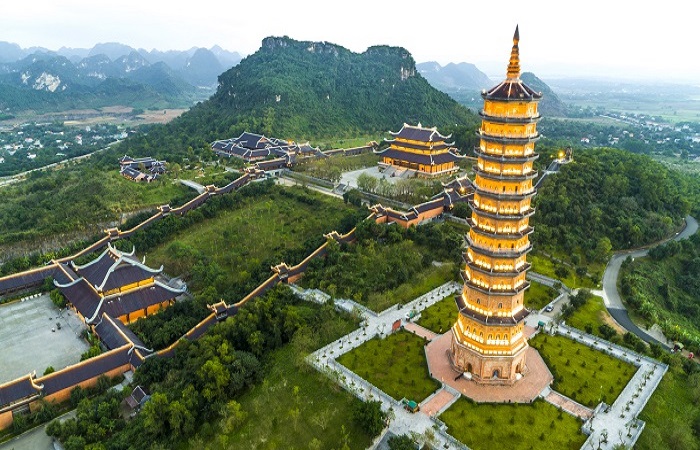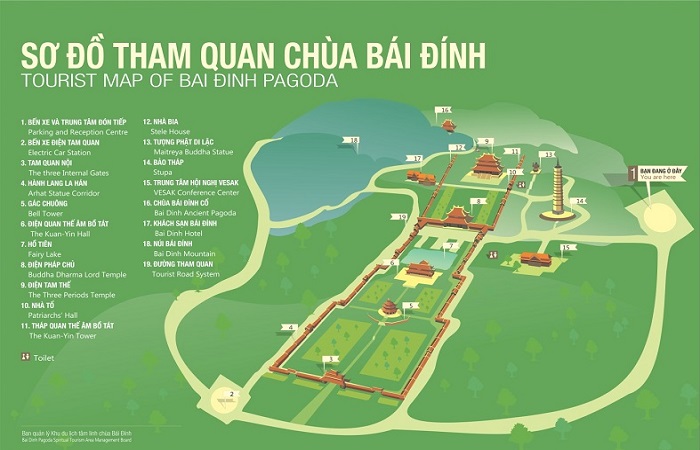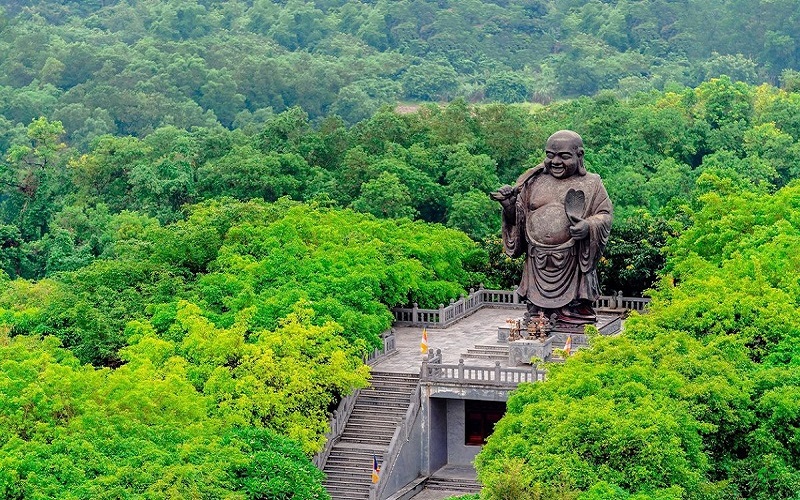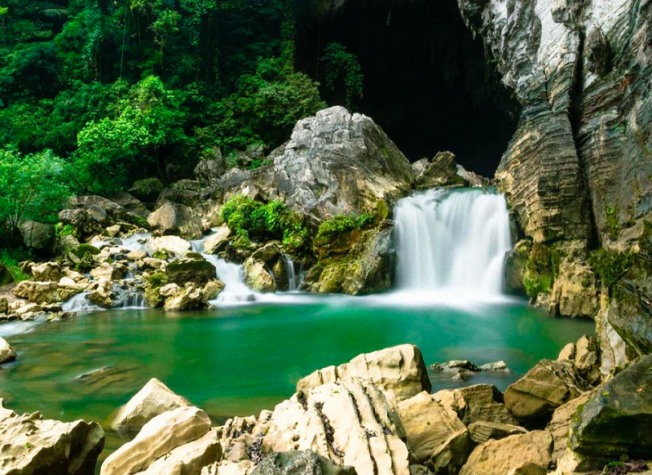Bai Dinh Pagoda in Ninh Binh: Things You Need to Know
Bai Dinh Pagoda Complex (Vietnamese: Chùa Bái Đính) in Ninh Binh Province is one of the most popular religious Sites in Northern Vietnam, and the Biggest Buddhist Temple of the country. Located very close to Trang An Complex, a UNESCO World Heritage Site, it is undeniably a must-see for pilgrimage and culture lovers. The complex of Bai Dinh Pagoda consists of an ancient pagoda and a newly constructed, larger temple. This is a major destination for Buddhist pilgrims all across the country.

- Location: Gia Sinh Commune, Gia Vien District, Ninh Binh Province
- Bai Dinh Pagoda Opening Hours: 6:00 AM - 10:00 PM from Mon - Sun
-
Entrance Fees:
- Bai Dinh Pagoda Entrance Fee: Free of Charge
- Electric Car: 30,000 VND/person/trip, operating until 8:00 PM
- Ticket Price to Bao Thap Tower: 50,000 VND/person
- Parking Fees: 40,000 VND/car and 15,000 VND/motorbike
History of the Bai Dinh Pagoda Complex in Ninh Binh:
Buddhism was very widespread and regarded as major religion of Vietnam under three feudal dynasties of the country including: Dinh (968-980), the Early Le (980-1009), and the Ly in Hoa Lu Ancient Citadel (1009-1010).

Photo Map of Bai Dinh Pagoda
Thus, during these periods, many pagodas were constructed in the region, notably the old Bai Dinh Pagoda on the western side of Dinh Mountain. The pagoda was built in the Dinh Dynasty, and it is where Emperor Dinh Tien Hoang erected a shrine to ask for favorable weather.
Other documents about Bai Dinh Pagoda history state that it was established in the Ly Dynasty as a place to contemplate, treat disease, and assist the locals. The pagoda has been described as one of the most important Buddhist, Taoist, and Mother Goddess worship sites.

Structure and Architecture of Bai Dinh Pagoda Complex:
The Bai Dinh Pagoda Complex consists of two main sites: the newly built Bai Dinh Pagoda and the ancient pagoda.
-
The new Bai Dinh Pagoda Vietnam complex:
The 700-hectare new Bai Dinh Pagoda is situated on Ba Rau Hill, close to Hoang Long River. This is a large complex with many buildings that were built between 2003 and 2010. The new pagoda’s architecture consists of huge halls, gardens, and enclosures.
Bai Dinh Pagoda is distinguishable from other Vietnamese Buddhist pagodas due to its immense size. Tam The Hall, the largest structure here, has a height of 34 meters and a length of over 59 meters. The building materials consist of the local stones and timbers from Ninh Binh and the tiles from Bat Trang Village.
The curved finials and soaring corner eaves of the pagoda, which look like a phoenix's tail, are typical of traditional Vietnamese architecture. Materials from traditional Vietnamese craft villages are used for the interior. These include the bronze sculptures from Y Yen, stone carvings from Ninh Van, woodwork from Phu Loc, and needlework from Ninh Hai.
-
The ancient Bai Dinh Pagoda:
The original pagoda is located approximately 800 meters away from the new one in the foothills. The walkway stretches more than 300 stone steps before passing beneath an elaborate gate to reach the entrance. The actual pagoda is nestled in many tiny caves on the slope. Together with Buddhist deities, mountain spirits are also worshiped here.
-
Outstanding landmarks :
- The Bell Tower: An octagon-shaped tower with three storeys of varying sizes. The base has a diameter of 49 meters. The tower is 22 meters tall and supported by a platform in the shape of a lotus. Inside is a bronze bell weighing 36 tons.
- The corridor with Arhat statues: The longest corridor in Asia that contains 500 Arhat Statues on both sides.
- Gieng Ngoc (The Pearl Well): This moon-shaped well was constructed around 1,000 years ago. The diameter is 30 meters and the depth is 6 meters.
- The Hall of Bodhisattva Avalokitesvara: This seven-compartment ironwood construction is 14.8 meters tall, 40.4 meters long, and 16.8 meters wide. Inside is an 80-ton bronze figure of Bodhisattva Avalokitesvara with many eyes and hands adorned with gold.
- Bao Thap Tower: A 100-meter-tall, 13-story structure with 72 stair steps, housing sacred Buddha relics from India and Burma.
- Maitreya Statue: A 10-meter-tall bronze statue located on the highest hill of Bai Dinh Pagoda. Weighing 80 tons, it is the largest outdoor bronze Maitreya Statue in Southeast Asia.
Some outstanding Records of Bai Dinh Pagoda Ninh Binh:
Bai Dinh Pagoda is renowned as one of the biggest Buddhist Temples in Southeast Asia. It is the holder of many national and also regional records. As of 2012, the pagoda holds nine outstading records, including:
- Record of the largest gilded bronze Buddha in Asia
- Record of the largest bronze Maitreya Buddha statue in SouRecord of theast Asia
- Record of the largest bronze bell in Vietnam
- Record of the tallest stupa in Asia
- Record of the largest pagoda complex in Vietnam
- Record of the longest Arhat corridor in Asia
- Record of the largest number of Arhat statues in Vietnam
- Record of the largest Pearl Well in Vietnam
- Record of the largest number of Bodhi trees in Vietnam
When is the Best Time to Visit Bai Dinh Pagoda?
The best time to take a tour to visit Bai Dinh Pagoda is in spring (from Jan to Mar in lunar month). At this time of year, Vietnam Weather and Temperature in the north is exceptionally pleasant.
It is a great time to go on sightseeing trip, take part in rituals at pagodas, and enjoy beautiful festivals at Bai Dinh Pagoda and Trang An Complex. Bai Dinh Pagoda Festival also takes place in spring.
However, spring is usually the peak local tourist season, and many placess are often overloaded. Hence, if you are not fond of the crowds, it is better to choose another time to visit this pagoda.
How to Get to Bai Dinh Pagoda in Ninh Binh?
Distance to Bai Dinh Pagoda Complex is about 95 kilometers away from Hanoi, 25 kilometers away from City Center of Ninh Binh City, and 12 kilometers away from Hoa Lu Ancient Citadel.
There are several means of transportation to travel from Hanoi to the pagoda, like bus, motorcycle, and car. It will take around 2 hours to travel by private car or tourist bus. If you choose a public bus, you will need to take a taxi to get from the bus stop to the pagoda.
Recommended Tours to Visit:
See Also:

![]()
![]()
![]()
![]()
![]()
Best of Vietnam

Best Vietnamese Food You Have to Try in Vietnam
Best Food in Vietnam: Vietnamese Traditional Food is top World well known to be both healthy and...

10 Best National Parks in Vietnam
Vietnam Travel Guide: If you look for the Best Wildlife Discovery Experience in Vietnam, here are...
Read More
Best Souvenir to Buy in Vietnam
If you look for Best Things to Buy when traveling to Vietnam to bring home for your family & friends...
Read More
The 10 Best Places to Visit in Vietnam
Vietnam Travel Guide: Home to an extensive collection of historical and cultural attractions,...
Read More
Top 10 Museums You Should Not Miss in Vietnam
Vietnam, 4.000 years old country has a unique and lengthy history, culture with 54 ethnic groups. It...
Read MoreFind your trip
Vietnam Best Tours
Vietnam Car Rental
Vietnam Travel Blog
- Vietnamese People: Origin, History, Culture and Traditions
- Vietnam Currency: Best ATM and Places to Exchange Money
- Vietnam Map: Regions, Cities & Provinces Map of Vietnam
- What is illegal Things in Vietnam: Rules & Laws for Tourists
- Best Time to Travel to Vietnam to Avoid the Bad Weather
- Vietnam News: Population & Religions of 54 Ethnic Groups









